Physical Address
304 North Cardinal St.
Dorchester Center, MA 02124
Histopathological examination of liver tissue by needle biopsy remains an integral part of the management of liver diseases, as morphology is of critical importance for synthesizing clinical and laboratory testing findings into cogent understanding of a patient’s liver disease. Liver biopsies were documented in the late 19th century, when Ehrlich and then Lucatello performed liver puncture through a laparoscope, primarily for chemical studies. Schupfer in 1907 is credited with the first application of liver biopsy for the diagnosis of cirrhotic liver disease in humans.
In 1938, the Vim-Silverman needle was introduced. This needle required the patient to hyperventilate for 30 seconds, and then hold his or her breath for the 2 to 6 seconds of needle manipulation within the liver. This procedure carried considerable risk of post-biopsy bleeding. Introduction of the rapid Menghini needle biopsy technique in 1958 dramatically expanded the use of liver biopsy, because it took less than 1 second and was safer and easier to use, while providing adequate tissue for histopathology and other studies. Although fibrotic and cirrhotic liver tissue is more likely to fragment during Menghini biopsy sampling, when compared with use of larger “cutting” needles, the safety profile for Menghini and other rapid needle sampling techniques ensured the latter’s popularity for percutaneous access. , Introduction of transjugular biopsies enabled liver tissue samples to be obtained in patients with suboptimal coagulation indices or with ascites. Open or laparoscopic biopsy such as during bariatric surgery adds to operative time but does not carry increased risk as measured by bleeding complications, length of postoperative stay, morbidity, or death. Intraoperative needle biopsy samples tissue from deeper within the liver, avoiding the risk of misinterpreting anatomically normal subcapsular fibrosis as might be the case with intraoperative wedge biopsy. Endoscopic ultrasound-guided liver biopsy can generate an adequate tissue biopsy for assessment of tumors that are less accessible by a percutaneous route, but the argument is made that percutaneous ultrasound-guided needle biopsy is still the more reliable technique for obtaining adequate biopsies of localized lesions. The various liver biopsy techniques are summarized in Table 44.1 .
| Methods | Technique | Considerations and Risk |
|---|---|---|
| Percutaneous (blind) | Suction needle (Menghini, Klatskin, Jamshidi) or cutting needle (Vim-Silverman, Tru-cut) | Most common, least costly, and least invasive liver biopsy. Provides an adequate specimen for histological evaluation and for other ancillary studies. Complications and specimen outcome related to the operator’s experience. May rarely result in an inadvertent biopsy of other organs, including kidney, pancreas, lung, gallbladder, and intestine. |
| Transjugular (transvenous) | Catheter through the internal jugular vein, right atrium, and inferior vena cava | Performed in patients with coagulation disorders, fulminant hepatic failure, gross ascites, or severe obesity. Greater effort and time required compared with percutaneous biopsy. Multiple specimens of good quality can be obtained, especially with experienced operators. Also possible to measure hemodynamics if combined with wedged hepatic pressure and venography. Complications include arrhythmia, contrast-related reaction, and inadvertent biopsy of kidney. |
| Laparoscopic or open | Providing direct visualization of the liver and peritoneal cavity; needle or wedge biopsy | Wedge biopsy provides a larger specimen, but if too superficial may lead to misinterpretation of liver “fibrosis,” owing to penetration of anatomically normal fibrous septa of Glisson’s capsule into the immediately subjacent liver parenchyma (to a depth of about 0.5 cm). Needle biopsy is a smaller sample but penetrates deeper into the liver so it can provide better information about the stage of liver fibrosis. Risk of anesthesia and hemorrhage; hemostasis may be monitored visually at the time of biopsy, and Gelfoam plug used if needed. Popularity of laparoscopic bariatric surgery for obesity has increased the number of intraoperative biopsies for evaluation of steatohepatitis and fibrosis. |
| CT or ultrasound-guided | <1-mm gauge needle typically used (fine-needle aspiration); ultrasound or CT used for visualization of hepatic lesion and to avoid intersecting vessels | For cytological or histological diagnosis of space-occupying lesion or sampling of cystic lesions. Multiple aspirations can be safely performed to ensure an adequate specimen. Immediate assessment of adequacy is possible. Cell block may increase sensitivity and allow additional staining; needle core tissue fragments are fixed and processed for routine histology. Risk of bleeding complications much lower compared with routine percutaneous needle biopsy. Seeding of needle tract by malignant cells is rare; does not appear to worsen prognosis. |
The indications for liver biopsy are given in Box 44.1 . Many liver biopsies are performed for chronic viral hepatitis, steatohepatitis, and allograft dysfunction to assess the degree of liver damage or the response to therapy. Acute hepatitis is usually not an indication for liver biopsy, but if there is doubt about the clinical diagnosis, multifactorial causes of elevated liver enzyme values, or even a mistaken working diagnosis, a biopsy may be indicated. Although surrogate laboratory testing for liver disease and noninvasive imaging techniques (particularly elastometry) and sustained virological response to antiviral therapies argue for decreased frequency of liver biopsy, histological features other than fibrosis stage continue to have an effect on both understanding disease process and provide insight into prognosis and response to therapy. Moreover, many patients with chronic liver disease present with already advanced disease, and histological evaluation is critical to determine the severity of liver damage. Lastly, as the liver is susceptible to insult from multiple agents simultaneously, liver biopsy is valuable for assessing the potential coexistence of different forms of liver injury. A key example is the allograft liver, when recurrent disease such as hepatitis C infection may be simultaneously present with organ rejection and/or drug-induced liver injury (see Chapters 49 and 53 ). Interpretation of the hepatic morphology plays a critical role in guiding clinical management.
Evaluation of abnormal liver test results
Evaluation of fever of unknown origin
Evaluation of jaundice of unclear origin
Evaluation of portal hypertension and ascites
Evaluation of hereditary or metabolic disease
Evaluation of abnormal serum iron study result
Diagnosis, grading, and staging of chronic hepatitis
Monitoring the effects of new or established therapy
Diagnosis, grading, and staging of chronic biliary disease
Confirmation of fatty liver and grading and staging of steatohepatitis
Diagnosis of space-occupying lesions
Evaluation of donor and posttransplant livers
Although relatively safe, liver biopsy is an invasive procedure, and the indications, goals, and techniques and their limitations should be carefully considered to avoid performing unnecessary procedures or preparation of a sample that cannot provide the necessary answer. As many as one-third of patients experience right upper quadrant pain or shoulder pain, which may be severe in 1% to 3%. Postprocedure bleeding is the key concern; major hemorrhage occurs in 0.3% of procedures, almost all presenting within 24 hours of biopsy. Less common complications include transient bacteremia, biliary leak with bile peritonitis, or injury to adjacent organs such as the gallbladder, colon, or right lung. The mortality rate associated with different techniques is approximately 0.01%. Rare complications of liver biopsy include hemobilia, pneumoperitoneum, pneumoscrotum, pneumothorax, septic shock, subphrenic abscess, and intrahepatic arteriovenous fistula. Although rare, seeding in the needle track has been reported in cases of hepatocellular carcinoma and metastatic colorectal carcinoma. , This minimal risk is balanced against the risk of selecting aggressive surgical treatment in a patient who does not have malignancy. The major contraindication to percutaneous liver biopsy is significant coagulopathy. Relative contraindications to percutaneous liver biopsy are morbid obesity and severe ascites. In these conditions, transjugular biopsy is a good alternative.
Fine-needle aspiration (FNA) biopsy guided by ultrasound or computed tomography (CT) has become the preferred method for diagnosis of a space-occupying lesion and confirmation of a suspected malignancy. , FNA biopsy provides immediate interpretation and assessment of the adequacy of a liver biopsy by using smears or touch preparations. Routine supplementation with a cell block of tissue fragments increases the diagnostic accuracy of FNA, and it provides material for immunohistochemical stains and ancillary studies for primary or metastatic malignant tumors. FNA biopsy can also be used to drain a cyst or abscess for culture and fluid analysis, or it can be followed by therapeutic ablation of malignant tumors. If echinococcal cyst is suspected and ultrasound imaging and serology are inconclusive, FNA sampling of the cyst fluid for evidence of protoscoleces or of antigens specific to Echinococcus granulosus may be considered but is best done with an anesthesiologist assisting, owing to the very low but present risk of anaphylaxis.
At the time of the biopsy procedure, a needle liver biopsy specimen should be examined immediately for adequacy. It should be at least 1.5 cm long, and if it is not, another pass is recommended because adequate specimen size minimizes sampling error. If a tumor is suspected, a touch preparation from the tissue can immediately determine specimen adequacy or a diagnosis. The specimen is then discharged into a Petri dish lined with lens paper, which has ideally been soaked in normal saline solution to prevent fresh tissue from adhering to it. Artifacts from squeezing or drying of the specimen should be avoided. Biopsy specimens should not be placed on dry gauze, which tends to dehydrate cells, resulting in a prominent nuclear artifact. Tissue squeezing distorts cells and elongates nuclei, which makes cytological evaluation of the specimen difficult.
Gross characteristics of the tissue, such as color, consistency, and tendency to fragment or float in the fixative solution, are documented by the physician. Tumors or granulomas, for example, can be recognized as white areas in otherwise reddish-brown tissue. Gray-black discoloration is seen in Dubin-Johnson syndrome, rusty brown in hemochromatosis, green in cholestasis, yellow in fatty liver, dark red in congested liver, and variegated or dark brown in metastatic melanoma. Fragmentation of specimens, especially in a transjugular biopsy specimen or when a Menghini (suction) needle is used, often indicates advanced fibrosis or cirrhosis.
Unless there are indications for special handling (see later), the liver biopsy cores should then be placed immediately in 10% neutral buffered formalin, which is the routine fixative for liver biopsies. Immersion of biopsies in saline causes discohesion of cells and distortion of the hepatocyte cords. The advantages of routine formalin fixation are that the formalin solution is stable; penetrates and fixes tissues well; is inexpensive; and allows subsequent application of most histochemical, immunohistochemical, and molecular pathology procedures. The characteristics of tissues fixed in formalin are well known. The disadvantage of formalin is the relative lack of cytological detail compared with some other types of fixatives such as Bouin’s or Zenker fixatives. However, the latter are contraindicated in this day and age owing to their inclusion of toxic heavy metals and their interference with molecular pathology analytics.
On the basis of the clinical diagnosis or possible differential diagnoses, the clinician determines which additional procedures may be required ( Table 44.2 ): fixation in 3% buffered glutaraldehyde for electron microscopy; fresh, unfixed tissue for viral and mycobacterial cultures; rapid freezing in liquid nitrogen or a mixture of dry ice and isopentane for fat stains, certain immunohistochemical and enzyme activity studies, quantitative studies of hormone receptors, and isolation of genomic and viral DNA and RNA for molecular analyses ; and fixation in 1% periodic acid in 10% neutral buffered formalin at 4° C for 48 hours for evaluation of glycogen storage diseases. When RNA recovery is needed, an alcohol-based fixative is better than a formalin fixative. When the patient is a child or a young adult, it may be beneficial to fix tissue in glutaraldehyde fixative in anticipation of possible ultrastructural studies.
| Ancillary Studies | Fixative or Procedure |
|---|---|
| Transmission electron microscopy | 3% buffered glutaraldehyde |
| Viral, bacterial, fungal cultures | Fresh, unfixed tissue or cystic aspirate |
| Fat stains, enzyme activity, protein analysis, viral DNA and RNA, in situ hybridization | Rapid freezing in liquid nitrogen or mixture of dry ice and isopentane |
| Glycogen storage diseases | 1% periodic acid in 10% neutral buffered formalin at 4° C for 48 hours |
| Flow cytometry of lymphocytes | Fresh, unfixed tissue in transport media |
| DNA analysis | 10% neutral buffered formalin |
| RNA analysis | Fresh tissue or fixed alcohol-based fixative (80% ethanol) |
| mRNA and miRNA analysis | Fresh tissue or fixed 10% neutral buffered formalin |
| Protein analysis | Fresh or fresh-frozen, unfixed tissue |
| Laser capture microdissection | Conventional tissue section from paraffin-embedded tissue block |
As noted, needle liver biopsy specimens should be placed immediately in the desired fixative, because the foundation of a good histological preparation is rapid and complete fixation. Good preservation of tissue can be achieved by following standard guidelines. First, the volume of the fixative should be at least 15 to 20 times the volume of the tissue. When transit to the laboratory is likely to involve much movement, the container should be filled to the brim with fixative to avoid the tissue specimen becoming adherent to a portion of the container that is not bathed in fixative. Second, sufficient time must be allowed for fixation to occur before processing is started. Because formalin penetrates most tissues at approximately 0.5 mm per hour at room temperature, sufficient time must be given for fixative to penetrate the tissue core (16-gauge needles have a nominal internal diameter of 1.19 mm; 18-gauge is 0.84 mm internal diameter). Fixation time may be shortened by application of heat, pressure, vacuum, agitation, or microwave techniques. When a histology slide is examined with the microscope, fragmentation of the central portion of the liver biopsy along the long axis is a sign of insufficient fixation time. Although prolonged formalin exposure (>24 hours) does not result in overfixation (i.e., hardening of tissue), it may reduce the availability of antigen sites for immunohistochemical studies. If there is residual tissue, it may be stored in 10% (or lower) neutral buffered formalin or in 70% alcohol.
Rush liver biopsy specimens should be manually processed to shorten the delay and meet the needs of critically ill or transplant patients; regular specimens are processed in an automated tissue processor. The application of microwave processing has significantly reduced processing time to as little as 15 minutes for a tiny biopsy specimen or to a 60- to 90-minute cycle for a larger biopsy specimen.
The functional unit of the liver is represented by the hepatic lobule of Kiernan or the hepatic acinus of Rappaport. , A hepatic lobule is viewed as a hexagonal region of the parenchyma, with portal tracts containing a portal vein, hepatic artery, and bile duct occupying three of the six apices of the hexagon, and the effluent “central” hepatic vein at the center of the hexagon. Hepatocyte cords are viewed as being arranged radially around the central vein. The microanatomic regions are referred to as “periportal,” “mid-zonal,” or “pericentral,” terms commonly used in hepatic pathology ( Fig. 44.1 ).
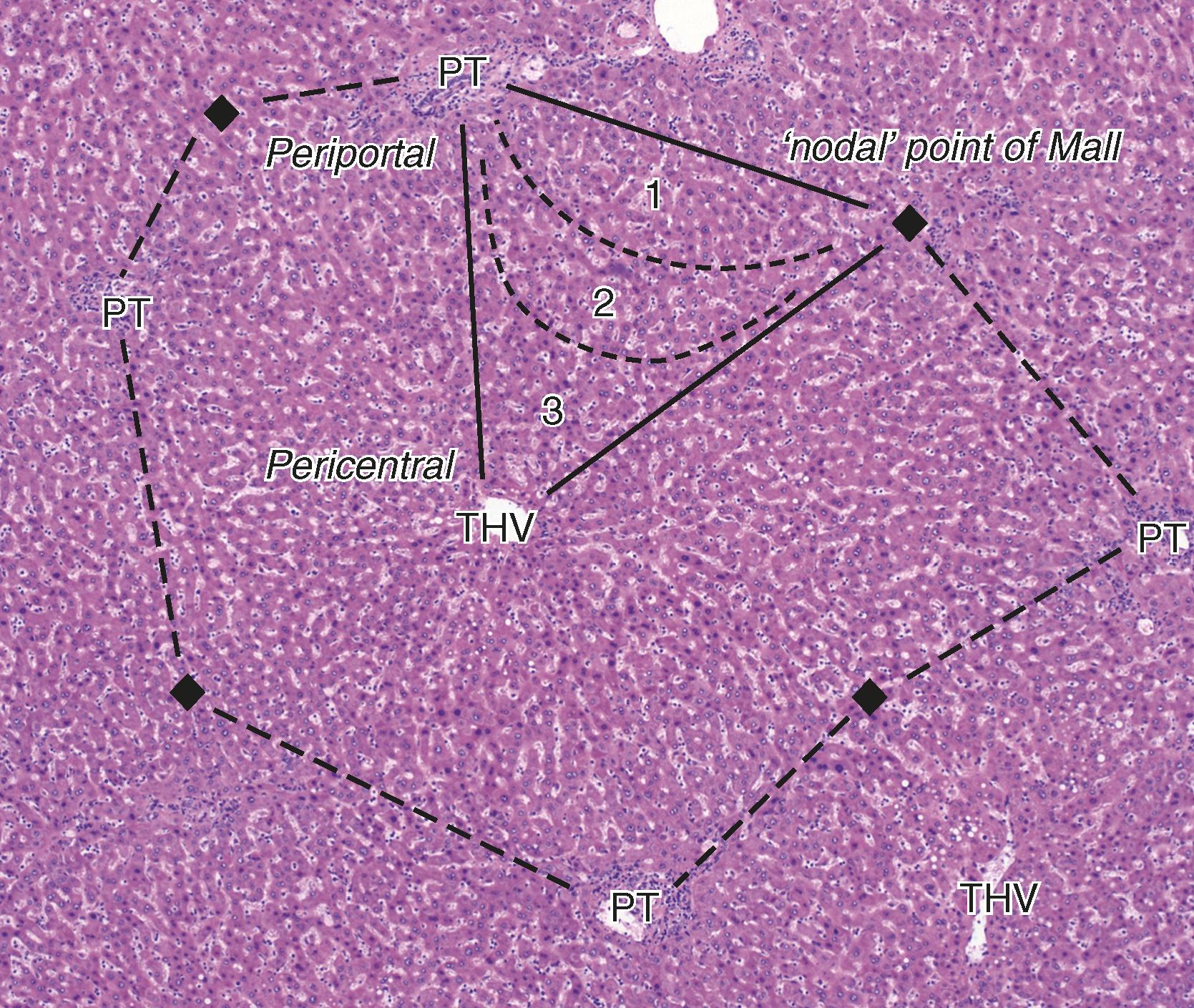
The Rappaport acinus is a more regular, three-dimensional structure in which the portal tract is at one point of the base of an isosceles triangle, and an effluent portal venule penetrates the parenchyma along the base of the triangle. The effluent vein is at the sharp apex of the triangle and is termed the “terminal hepatic vein.” Portal vein blood flows from the penetrating portal venule into the sinusoidal channels along a broad front, thence draining into the terminal hepatic vein.
Hepatic arterial blood supplies the plexuses that nourish interlobar, segmental, and sublobular portal veins and bile ducts; these plexuses drain into hepatic sinusoids. Terminal portal veins and interlobular bile ducts do not have an arterial plexus. Arterial blood that reaches the terminal hepatic arteries enters into periportal sinusoids via arteriosinus twigs. Isolated parenchymal arterioles may occasionally be seen within the periportal parenchyma.
The acinus is subdivided into zones 1, 2, and 3, indicative of progressively decreasing tissue oxygenation (see Fig. 44.1 ). The oxygen gradient, metabolic heterogeneity, and differential distribution of enzymes across the three zones of the acini help explain the zonal distribution of liver damage caused by hypoperfusion or ischemia and by certain toxic substances.
The hepatocyte is a polygonal epithelial cell with one or more centrally located, round nuclei. The number of binucleate forms increases with age ( Fig. 44.2 ). Some nuclei are larger than others, particularly in persons older than 60 years, indicating polyploidy. The significance of polyploidy is unknown. It is usually more prominent in the midzonal areas. Hepatocytes are arranged in one-cell-thick cords in adults, and they are separated by sinusoids, in which blood flows from the portal tracts to the terminal hepatic venules. In keeping with the continued growth of the liver in the early years of life, in children as old as 5 or 6 years, the liver cells are arranged in two-cell-thick plates ( Fig. 44.3 ). In adults, the presence of two-cell-thick hepatocyte plates and rosette formation, along with more uniformly sized nuclei and increased nuclear density, indicates hepatocyte regeneration ( Fig. 44.4 ). Rare eosinophilic bodies or apoptotic bodies may indicate normal turnover of hepatocytes in otherwise apparently normal adult livers. Hepatocyte mitotic figures are not usually seen except during hepatic response to parenchymal injury.
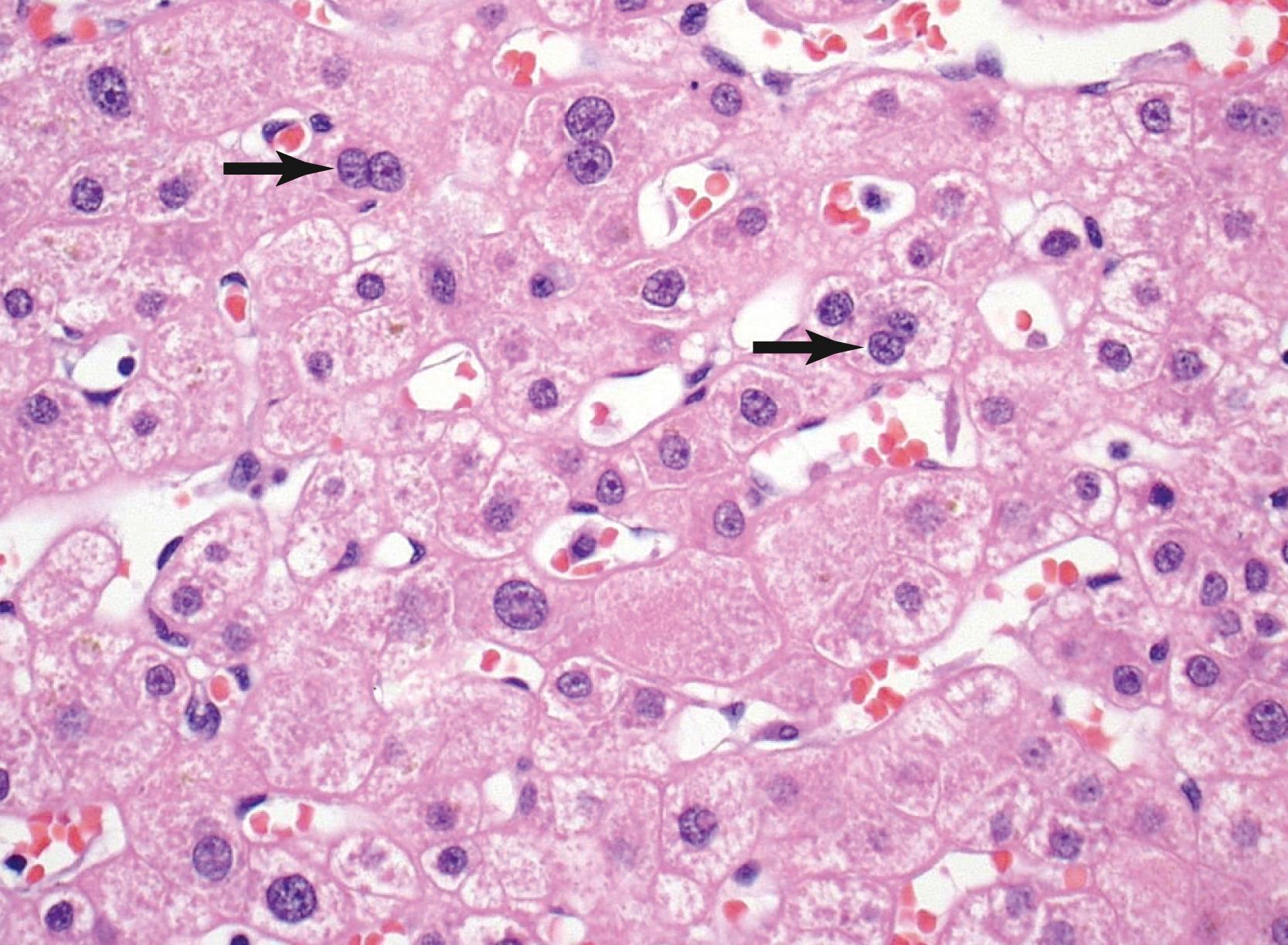
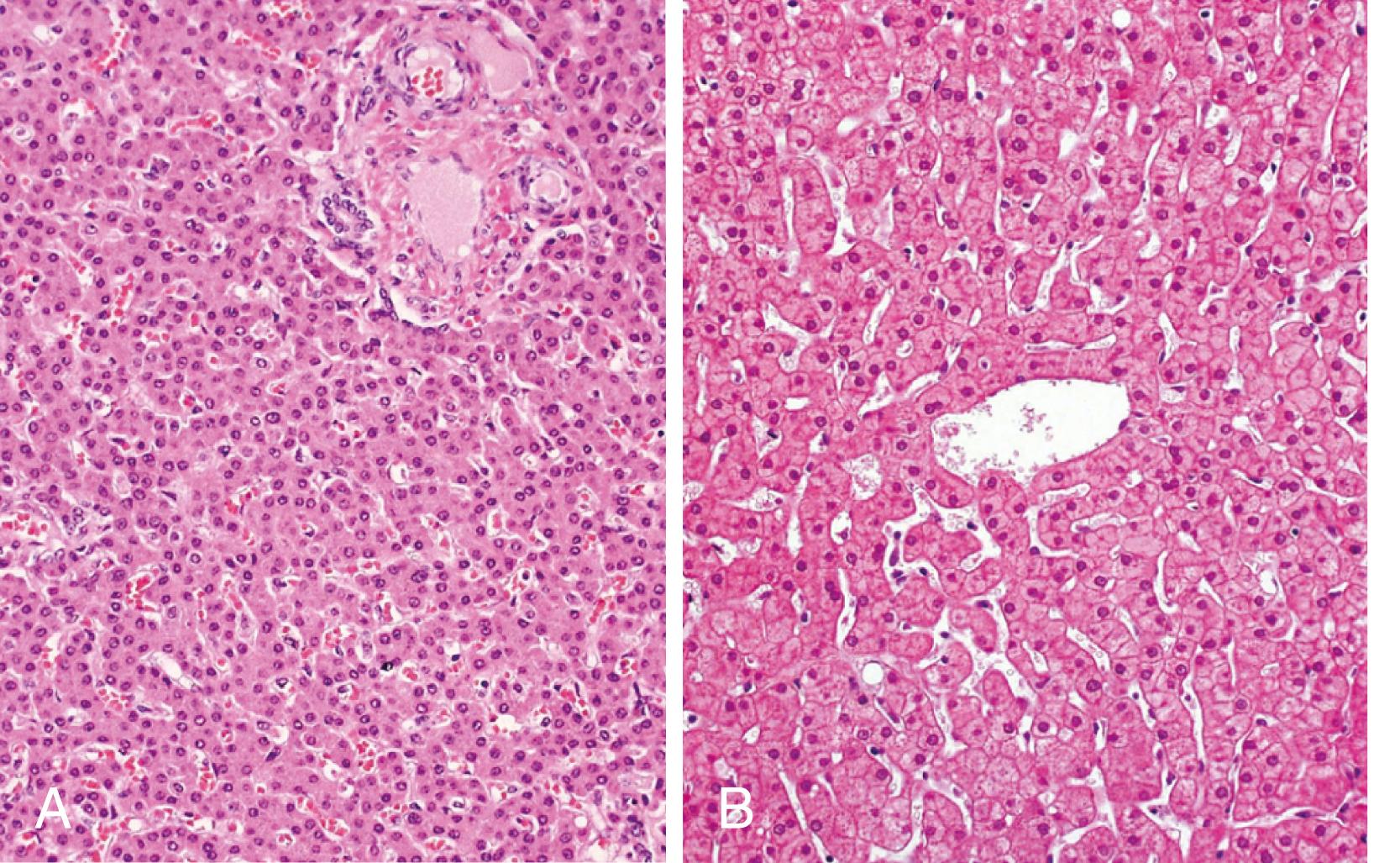
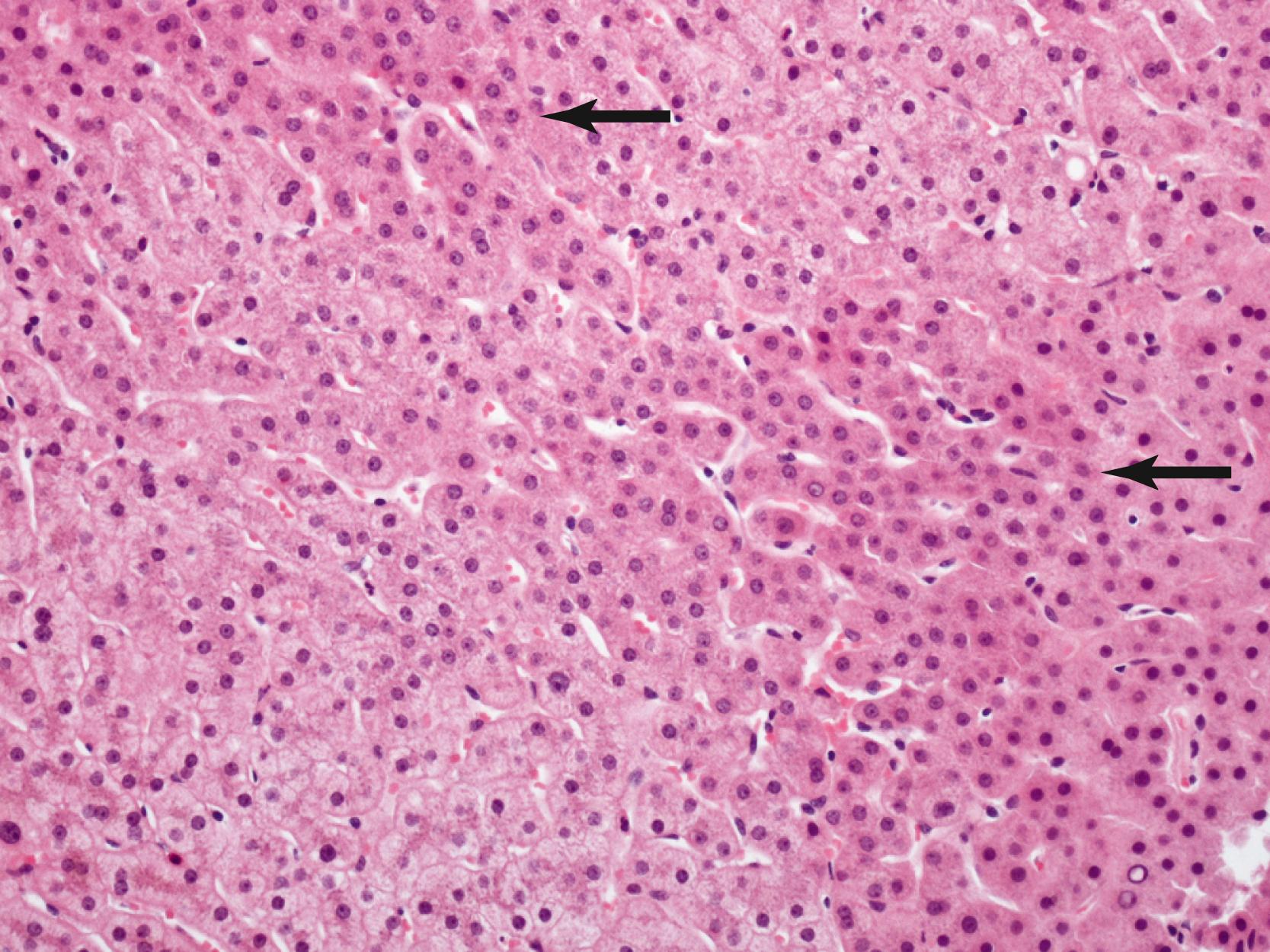
Glycogen accumulation in hepatocyte nuclei surrounding portal tracts produces a vacuolated appearance and is common in adolescents ( Fig. 44.5 ). In adults, this appearance may be conspicuous in conditions such as Wilson’s disease, metabolic syndrome, or diabetes mellitus. Cytoplasmic glycogen is normally present and imparts a fine, reticulated appearance to the cytoplasm. The distribution of glycogen also shows diurnal and diet-related variations. An irregular distribution pattern may be found in biopsies and is not of diagnostic significance. Owing to consumption of hepatocellular glycogen at the time of death, the hepatocytes in autopsy livers are more compact and do not show the reticulated cytoplasm of hepatocytes in liver biopsy specimens.
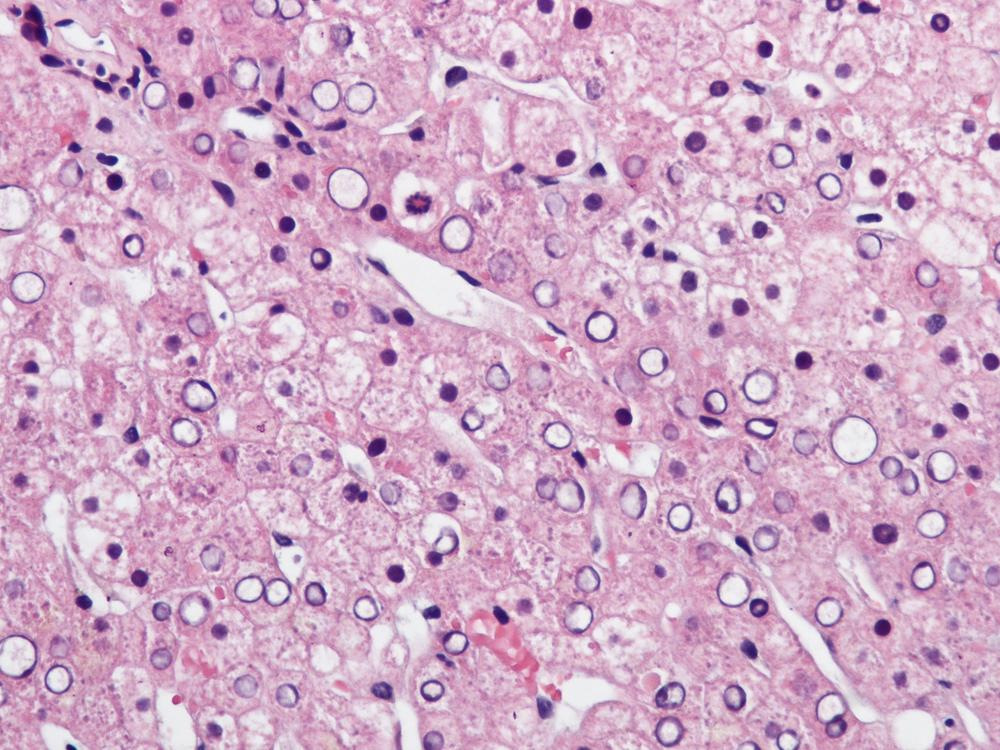
Lipofuscin pigment is normally seen in variable quantities in the centrilobular areas as fine, light brown granules centered around the canalicular region of the hepatocytes; the periodic acid–Schiff–diastase (PAS-D) stain highlights these granules. There is a progressive increase of lipofuscin in individual hepatocytes with age ( Fig. 44.6 ). The granules represent lysosomes that contain materials that cannot be further degraded; they are not present in recently regenerated hepatocytes. Bile is not visible under normal circumstances. Hepatocellular retention of bile in either obstructive or nonobstructive cholestasis is evident by brown fluid present in dilated bile canaliculi of hepatocytes in zone 3 (see Fig. 44.6 ); the hepatocyte cytoplasm may also exhibit brown discoloration on hematoxylin and eosin (H&E) stain. Retained bile can be distinguished from lipofuscin by its lack of a granular appearance and lack of refraction when the microscope condenser is lowered.
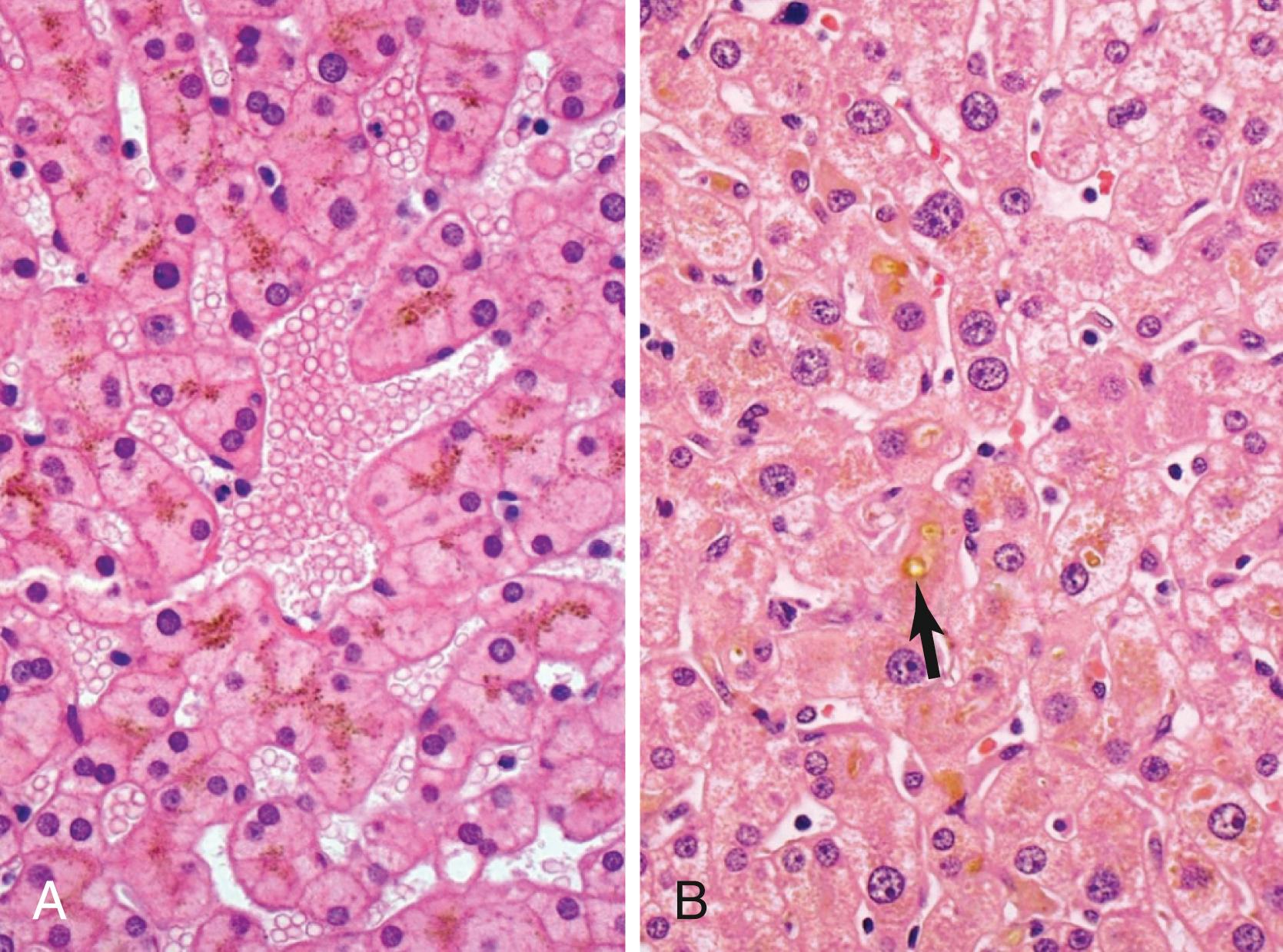
Large amounts of lipofuscin are difficult to distinguish from Dubin-Johnson pigment microscopically, although Dubin-Johnson pigment is not as refractile as lipofuscin. Compared with lipofuscin, iron and copper are coarser, birefringent, and usually deposited in periportal hepatocytes. Hemosiderin and copper are abundant in the cytoplasm of hepatocytes during the first week of life, then gradually disappear, and should be absent by the age of 9 months. Small quantities of stainable iron are common in normal hepatocytes, particularly in older individuals.
Sinusoidal lining cells consist of specialized fenestrated endothelial cells and specialized macrophages or Kupffer cells, which are usually inconspicuous in normal biopsy specimens. Occasional lymphocytes or neutrophils may be present in the sinusoids. Between the sinusoidal lining cells and the hepatocytes lies the space of Disse, which contains plasma, scanty connective tissue, and perisinusoidal cells such as hepatic stellate cells and pit cells (i.e., natural killer lymphocytes). Hepatic stellate cells are modified resting myofibroblasts that can store fat and vitamin A and produce hepatocyte growth factor and collagen. , They play a significant role in hepatic fibrogenesis. When activated, hepatic stellate cells contain stainable desmin and actin in their cytoplasm that can be highlighted with an immunohistochemical stain for smooth muscle actin. Elastic fibers and basement membrane material are absent from normal sinusoids. ,
Smaller branches of the sublobular hepatic veins and the terminal hepatic veins are in direct contact with the hepatocyte parenchyma. The terminal hepatic veins have very thin walls lined by endothelial cells. Thickening of the wall of terminal hepatic veins is often part of a pericellular fibrosis reaction and of central hyalin sclerosis in alcoholic liver disease. , It also may be seen focally in apparently normal individuals.
Portal tracts of different sizes may be seen in biopsy specimens. Defining a portal tract as a focus within the parenchyma containing at least two luminal structures embedded in a connective tissue mesenchyme with a continuous connective tissue circumference, a percutaneous liver biopsy may contain from 3 to more than 20 portal tracts, with the number directly proportional to the length of the biopsy (approximately 6 portal tracts per linear centimeter of tissue core biopsy). On a per specimen basis, in a normal liver, 38% of portal tracts may not contain a portal vein; 9% may not contain a hepatic artery; and 7% may not contain a bile duct. Hepatic arteries and bile ducts almost always travel together as a pair, and the external diameter of the paired structures are comparable. Given the more variable presence of portal veins, portal dyads (hepatic artery:bile duct) are almost as common as portal triads in normal peripheral liver tissue. These numbers reflect the variable anatomy of the terminal ramifications of the portal tree.
The amount of connective tissue and the size of intraportal structures depend on the size of the portal tracts. Pathological processes do not necessarily affect large and small portal tracts to the same extent. Portal tracts normally contain a few lymphocytes, macrophages, and mast cells but do not contain neutrophils or plasma cells. The number of inflammatory cells increases with age and typically varies from one portal tract to another.
The larger intrahepatic or septal bile ducts are lined by tall columnar epithelial cells, and the smaller or interlobular bile ducts are lined by cuboidal or low columnar epithelium. Larger bile ducts have more periductal fibrous tissue than smaller ones. Sizeable bile ducts are often seen in subcapsular liver parenchyma in liver biopsies. Bile ductules are variably located at the peripheral zone of the portal tracts, and they are smaller than interlobular bile ducts. They have a basement membrane and are lined by cuboidal cholangiocytes. These ductules are the connecting conduit between the interlobular bile ducts and canals of Hering, which reside at the portal tract:parenchyma interface and penetrate a short distance into the parenchyma. The bile canalicular channels that course between hepatocytes drain into canals of Hering and thence into the formal biliary tree. Bile canaliculi are not readily recognized microscopically unless distended, as in parenchymal cholestasis. Bile ductules and canals of Hering are thought to represent the progenitor cell compartment of the liver. With hepatocellular injury, particularly at the portal tract interface, this progenitor compartment becomes highly replicative, termed “ductular reaction.”
Lymphatic channels are not evident in the normal portal tract but may become visible in fibrotic and cirrhotic livers owing to increased lymphatic flow. The meticulous work of Franklin Mall more than a century ago identified interstitial spaces in portal tract stroma of the liver, which were continuous between periarterial, perivenular, and periductal compartments (the “space of Mall”). Cenaj et al. have recently demonstrated that this fluid-filled interstitium is indeed a unified network that is in continuity with the vascular (ingress) and lymphatic (egress) fluid systems in the liver.
There are several changes in the liver related to aging, particularly in individuals older than 60 years ( Fig. 44.7 ). There is more variation in the size of hepatocytes and the number of their nuclei (i.e., polyploidy) and an increase in lipofuscin pigment deposition. There may be apparent dilation of sinusoids because of hepatocyte cord atrophy. The portal tracts may contain denser collagen and may contain an increased quantity of mononuclear inflammatory cells. The hepatic arteries may have thickened walls, even in normotensive individuals. These changes are accompanied by alterations in the metabolic function of the liver, including the metabolism of various toxins and drugs.
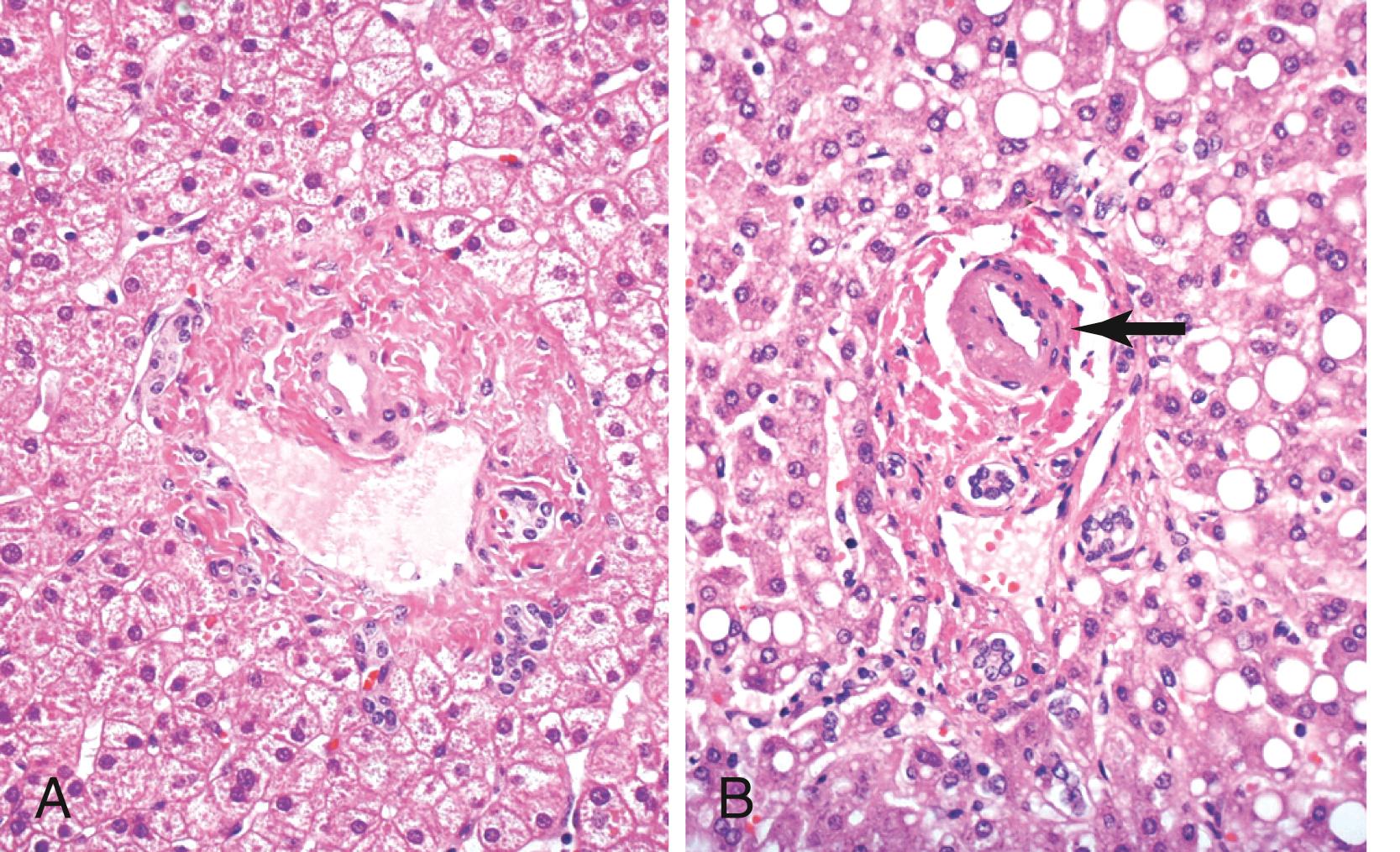
Histological examination of liver biopsies should conform to a specific routine and include inspection of all tissue fragments and structures of the liver (i.e., architecture, portal tracts, parenchyma, and terminal hepatic veins). A systematic approach ensures that important diagnostic findings are not overlooked, including specific attention to the vasculature, biliary tree, hepatocytes and sinusoids, stroma, and inflammation. A sensible approach is to begin the examination with a low scan magnification to appreciate the lobular architecture, the presence and quantity of the various anatomic structures of the liver, and the presence or absence of normal structures or focal changes. At low magnification, the type and location of inflammation and steatosis can be well appreciated. This should be followed by a careful examination of portal tracts and its anatomic structures, zones 1, 2, and 3 of the acinus and specifically evaluating the presence or absence of hepatocellular steatosis, necrosis, apoptosis, cholestasis, ballooning degeneration, Mallory-Denk bodies, and pigments. The pattern of inflammation must be explicitly observed, including the presence or absence of granulomas. Specific histopathological changes may be easily recognizable, but it is often the cumulative topographical and morphologic relationships of the structures of the liver determined by systematic examination that contribute to a clinically meaningful interpretation.
Two schools of thought pertain to whether the initial histological examination of a liver biopsy specimen is better conducted without knowledge of the clinical and laboratory information, so that observations are unbiased; or with such knowledge, so that the initial histological examination is informed by searching for pertinent positive and negative findings. Regardless, once the morphological changes are appreciated and a generalized pattern of injury has been ascertained, a differential diagnosis can be rendered in combination with the clinical and laboratory information. Clinical information and laboratory data should always be reviewed before submitting a final interpretation, because more often than not, this information is essential in narrowing the differential diagnosis to a specific cause. Moreover, multiple injurious processes may be simultaneously operative, or acute injury from one cause may be superimposed on chronic injury from the same or another cause. The pathologist must consider multiple potential causes of injury, in the context of clinical and laboratory data, so as to avoid being erroneously simplistic in interpretation of the morphological findings.
The liver tends to react similarly to a broad range of injuries. In most instances, the needle biopsy is fairly representative unless portal tracts are underrepresented in a shorter needle core biopsy sample. However, a sampling error, particularly in focal or irregularly distributed disease processes, must always be taken into consideration. For example, in primary sclerosing cholangitis, the characteristic bile duct injury and periductal concentric fibrosis may not be uniformly seen throughout the liver or may not be present at all. All levels must be examined for morphological features, regardless of which histochemical stain and tinctural features any given level may have. Following portal tracts and terminal hepatic veins through these multiple levels may be highly informative. When searching for focal findings such as cytomegalovirus changes, it may be necessary to cut additional serial sections before the typical microabscesses are identified. Biopsy of space-occupying lesions may not show neoplastic cells in every section. In cirrhosis, a small-caliber needle biopsy may not obtain septal fibrosis and may yield only fragments of parenchyma without fibrosis or evident portal tract structures. This is to be distinguished from artefactual fragmentation of sampled tissue into smaller tissue fragments that may occur at the time of histological sectioning, and partial tears in the region of the terminal hepatic vein that may be observed.
Innocent variations that should be considered to avoid erroneous interpretation are subcapsular liver parenchyma and surgery-associated changes. Needle biopsy of the immediate 2-mm subcapsular space often shows parenchyma that mimics cirrhosis ( Fig. 44.8 ) and that may give a false impression of the status of the liver as a whole. The liver capsule may be present in percutaneous liver biopsies at one end of the specimen or in the form of separate pieces of connective tissue. The capsule can be distinguished from most pathological fibrous tissue by its density and maturity, and it often contains blood vessels and bile ducts. Similar artifacts can be found in biopsy samples when the needle enters the liver at an angle close to the capsule or in a wedge biopsy that contains capsular fibrosis tissue on two surfaces.
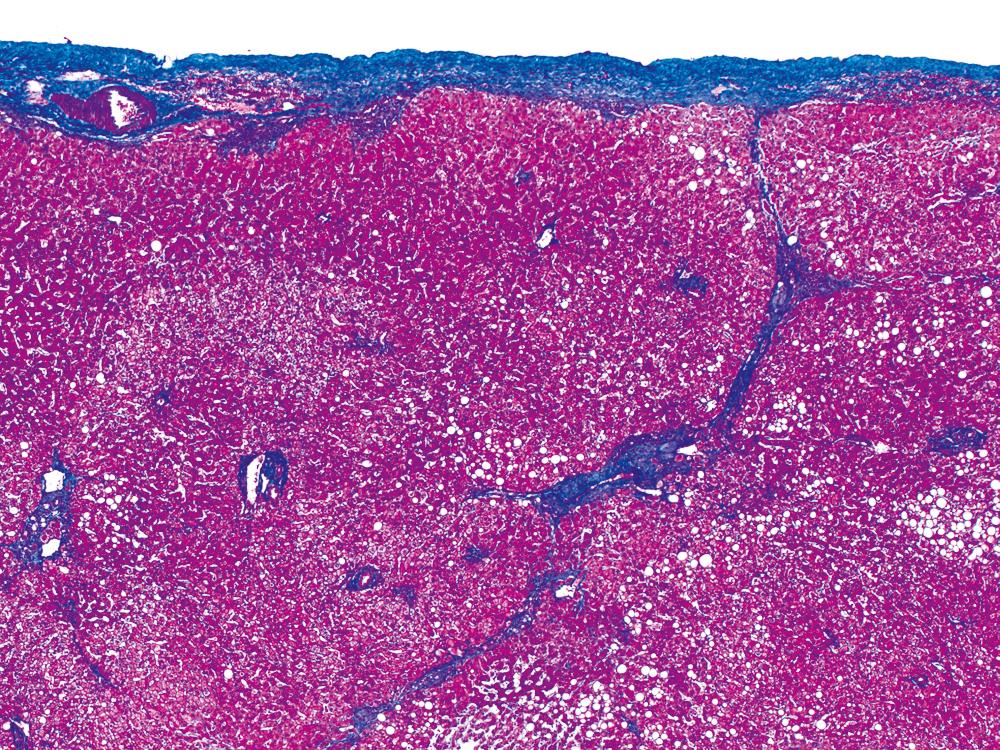
In liver biopsy specimens obtained at the end of a long surgical procedure, surgery-associated changes are usually seen as small, tight clusters of neutrophils within or under the hepatic capsule, sinusoids around central venules, portal tracts, and hepatic plates, and they resemble microabscesses ( Fig. 44.9 ).
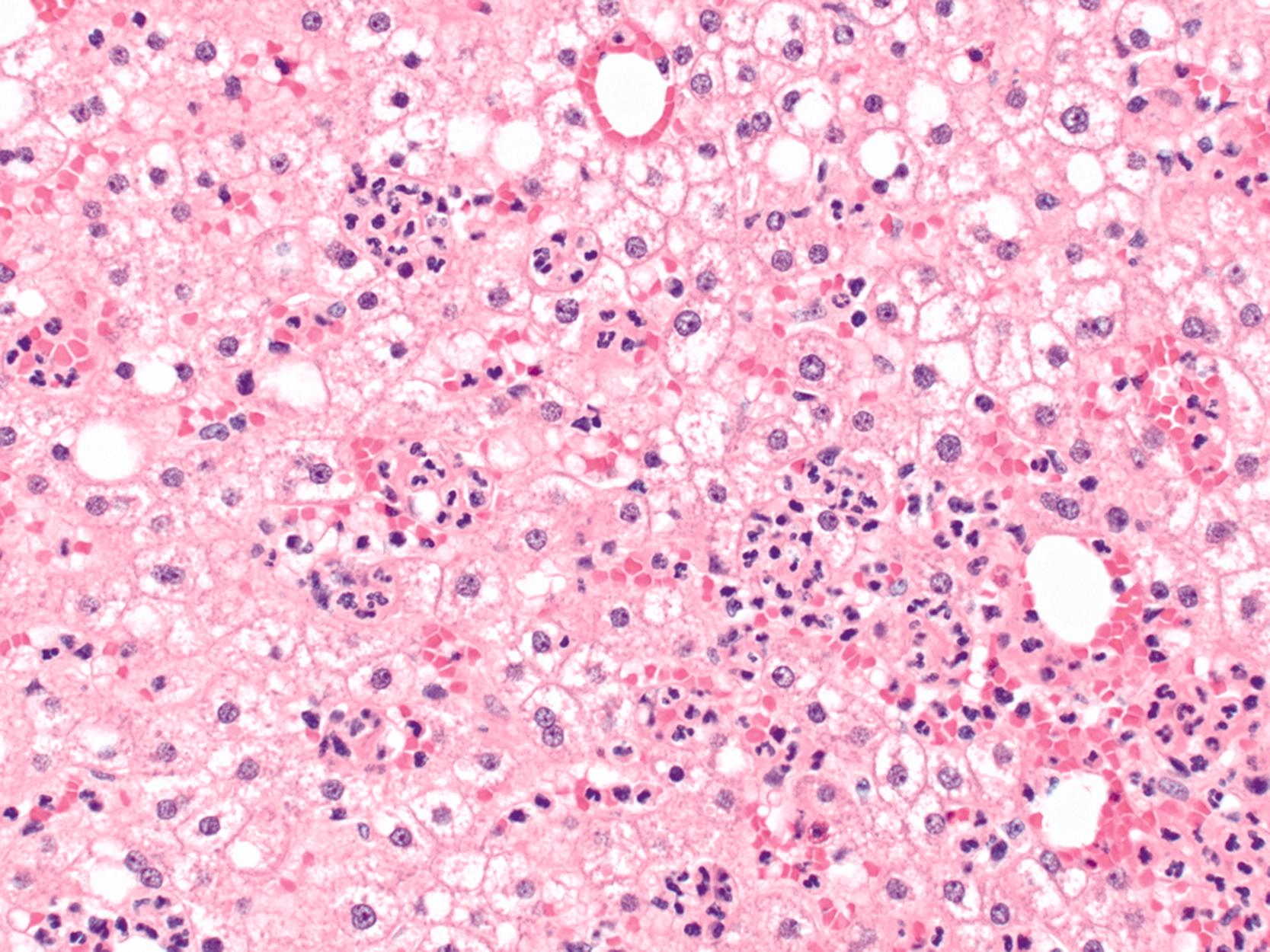
Other normal variations or innocent hepatic lesions include focal steatosis involving small groups of hepatocytes, fat granulomas from mineral oil deposition in perivenular areas and portal tracts, rare acidophilic bodies in an otherwise normal liver, and unexplained mitoses of hepatocytes that normally have a life span of many years. In biopsies of space-occupying lesions, nonspecific reactive changes also may be seen. These changes are important to observe in biopsies that do not include neoplastic tissue, a cyst, or an abscess. The histological changes, described by Gerber and coworkers as a histological triad , consist of a ductular reaction, portal tract edema, and sinusoidal dilation. They may be subtle, are usually focal, and typically involve small portal tracts. These changes most likely occur as a result of local obstruction of blood and bile flow in the setting of an expanding lesion.
Partial liver resections are usually performed to remove focal lesions. The extent of resection varies from removal of small wedges of tissue to the removal of the entire lobe. In resection specimens, several surfaces may be covered by the hepatic capsule. The surface that is not invested by Glisson capsule is the surgical margin and may be designated by the surgeon with different colors of ink or stitches, especially when the lesion is close to a particular margin of concern. After the margin is identified and the specimen is oriented, the specimen should be weighed and measured in each dimension. Often, a bulge in the surface of the liver or retraction of the capsule can help to localize an intraparenchymal mass.
The characteristics of the lesions and of the surrounding liver parenchyma should be described. The presence or absence of involved resection margins, significant fibrosis of the liver parenchyma, or cirrhosis is observed. The specimen should be serially sectioned at 0.5- to 1-cm intervals, with the initial section passing through the center of the tumor to demonstrate the closest approach of the mass to the resection margin. Specimen photographs and representative sections may be taken. Fresh tissue or tissue in fixatives other than formalin should be submitted for additional tests when applicable.
Become a Clinical Tree membership for Full access and enjoy Unlimited articles
If you are a member. Log in here